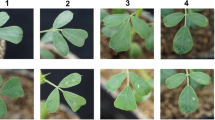Abstract
Objectives
To exploit cold-inducible biochemical processes beneficial for foreign mRNA transcription, translation and storage, as well as protein product stability, during Agrobacterium-mediated transient expression.
Results
The efficiency of three different 5′-regulatory sequences to achieve transient expression of the GFP-based reporter gene under chilling conditions (6–8 °C since the 3rd day post inoculation) was compared. We studied the upstream sequences of a cold-inducible Arabidopsis thaliana cor15a gene, the core element of 35S CaMV promoter fused to the TMV omega 5′-UTR, and the synthetic promoter including the 35S core sequence and two binding sites for cold-inducible CBF transcription factors (P_DRE::35S). Cultivation of plants transiently expressing reporter gene under control of the synthetic P_DRE::35S promoter under chilling conditions since the 3rd dpi led to the reliably higher reporter accumulation as compared to the other tested regulatory sequences under chilling or greenhouse conditions. Reporter protein fluorescence under chilling conditions using P_DRE::35S reached 160% as compared to the transient expression in the greenhouse. Period of transient expression considerably extended if plants were cultivated at chilling temperature since the 3rd dpi: reporter protein fluorescence reached its maximum at the 20th dpi and was detected in leaves up to the 65th dpi. The enhanced protein accumulation at low temperature was accompanied by the prolonged period of corresponding mRNA accumulation.
Conclusion
Transient expression under chilling conditions using synthetic cold-inducible promoter enhances target protein accumulation and may decrease greenhouse heating expenses.


Similar content being viewed by others
References
Al-Fageeh MB, Smales CM (2006) Control and regulation of the cellular responses to cold shock: the responses in yeast and mammalian systems. Biochem J 397:247–259
Al-Fageeh MB, Marchant RJ, Carden MJ, Smales CM (2006) The cold-shock response in cultured mammalian cells: harnessing the response for the improvement of recombinant protein production. Biotechnol Bioeng 93:829–835
Amiri RM, Yureva NO, Shimshilashvili KM, Goldenkova-Pavlova IV et al (2010) Expression of acyl-lipid Delta12-desaturase gene in prokaryotic and eukaryotic cells and its effect on cold stress tolerance of potato. J Integr Plant Biol 52:289–297
Baker SS, Wilhelm KS, Thomashow MF (1994) The 5′-region of Arabidopsis thaliana cor15a has cis-acting elements that confer cold-, drought- and ABA-regulated gene expression. Plant Mol Biol 24:701–713
Buyel JF, Fischer R (2013) Processing heterogeneous biomass: overcoming the hurdles in model building. Bioengineered 4:21–24
Cazzonelli CI, Velten J (2006) An in vivo, luciferase-based, Agrobacterium-infiltration assay system: implications for post-transcriptional gene silencing. Planta 224:582–597
Del Toro F, Tenllado F, Chung BN, Canto T (2014) A procedure for the transient expression of genes by agroinfiltration above the permissive threshold to study temperature-sensitive processes in plant-pathogen interactions. Mol Plant Pathol 15:848–857
Fujiuchi N, Matoba N, Matsuda R (2016) Environment control to improve recombinant protein yields in plants based on Agrobacterium-mediated transient gene expression. Front Bioeng Biotechnol 4:23
Fullner KJ, Nester EW (1996) Temperature affects the T-DNA transfer machinery of Agrobacterium tumefaciens. J Bacteriol 178:1498–1504
Goldenkova IV, Musiychuk KA, Piruzian ES (2003) Bifunctional reporter genes: construction and expression in prokaryotic and eukaryotic cells. Mol Biol 37:307–313
Jaenicke R (1990) Protein structure and function at low temperatures. Philos Trans R Soc Lond Ser B 326:535–551
Miura K, Furumoto T (2013) Cold signaling and cold response in plants. Intern J Mol Sci 14:5312–5337
Narasimhulu SB, Deng XB, Sarria R, Gelvin SB (1996) Early transcription of Agrobacterium T-DNA genes in tobacco and maize. Plant Cell 8:873–886
Prasad TK (2001) Mechanisms of chilling injury and tolerance. In: Basra AS (ed) Crop responses and adaptations to temperature stress. Haworth Press Inc, New York, pp 1–34
Sheludko YV, Sindarovska YR, Gerasymenko IM, Bannikova MA, Kuchuk NV (2007) Comparison of several Nicotiana species as hosts for high-scale Agrobacterium-mediated transient expression. Biotechnol Bioeng 96:608–614
Voinnet O, Rivas S, Mestre P, Baulcombe D (2003) An enhanced transient expression system in plants based on suppression of gene silencing by the p19 protein of tomato bushy stunt virus. Plant J 33:949–956
Wulhfard S, Tissot S, Bouchet S, Cevey J, De Jesus M, Hacker DL, Wurm FM (2008) Mild hypothermia improves transient gene expression yields several fold in Chinese hamster ovary cells. Biotechnol Prog 24:458–465
Zarka DG, Vogel JT, Cook D, Thomashow MF (2003) Cold induction of Arabidopsis CBF genes involves multiple ICE (inducer of CBF expression) promoter elements and a cold-regulatory circuit that is desensitized by low temperature. Plant Physiol 133:910–918
Zhang C, Liu MS, Xing XH (2009) Temperature influence on fluorescence intensity and enzyme activity of the fusion protein of GFP and hyperthermophilic xylanase. Appl Microbiol Biotechnol 84:511–517
Acknowledgement
The authors are grateful for financial support to National Academy of Science of Ukraine, Grant № UkrISTEI 0115U004171, and Alexander von Humboldt Foundation (Georg Forster Research Fellowship (HERMES) for experienced researchers 2015). We thank Dr. V. Dosenko (O. O. Bohomolets Institute of Physiology, Kyiv, Ukraine) for help with RT-qPCR measurements and Dr. Polina V. Lishko (University of California, Berkeley, USA) for linguistic advice.
Supporting information
Supplementary Figure 1—Scheme of transcriptional units for expression of the bifunctional reporter gene GFP::LicBM3 under control of different 5'-regulatory sequences.
Supplementary Figure 2—The comparison of GFP fluorescence in plants transiently expressing reporter gene driven with P_35S and P_DRE::35S under chilling and greenhouse conditions.
Supplementary Figure 3—Relative level of the reporter transcript compared to the actin mRNA and the mean Ct values of the reporter and actin mRNA.
Supplementary Table 1–21—The results of detailed t-test analysis for difference between fluorescence means for the three studied regulatory sequences for chilling and greenhouse conditions.
Author information
Authors and Affiliations
Corresponding author
Electronic supplementary material
Below is the link to the electronic supplementary material.
Rights and permissions
About this article
Cite this article
Gerasymenko, I.M., Sheludko, Y.V. Synthetic cold-inducible promoter enhances recombinant protein accumulation during Agrobacterium-mediated transient expression in Nicotiana excelsior at chilling temperatures. Biotechnol Lett 39, 1059–1067 (2017). https://doi.org/10.1007/s10529-017-2336-z
Received:
Accepted:
Published:
Issue Date:
DOI: https://doi.org/10.1007/s10529-017-2336-z




